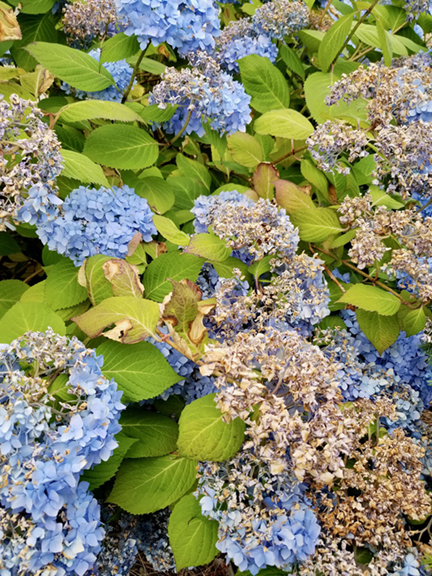Gardening in the drought

By Margie Lachman
Looking around my garden, I am noticing the plants that are damaged from the heat event that we all endured recently. My water bill increased several times the last few months since I turned on my sprinkling system.

Pots of geraniums on the west-facing driveway have a few brown leaves but are mainly green. Their fuzzy leaves resist dehydration. A fuchsia on the east facing deck was severely burned even in shade! It is recovering with new leaves. Some shrubs, Hydrangea quercifolia ‘Little Honey’ is scorched, Lonicera nitida ‘Baggesnson’s Gold’ is very brown on all the ends of the branches, and bamboo Fargesia ‘Genf’ are damaged, but others are virtually unscathed by the extreme heat. Two Hydrangea macrophylla on the east side of the house show the importance of shade. One is shaded from 1pm on and is fine; next to it is its twin that is in sun until 4 pm and the topmost branches and flowers are burned. Most of my garden is watered on a drip system. It is efficient and keeps the surface dry with the help of two-three inches of compost so weeds seeds are discouraged from sprouting.
In recent years I have looked for drought tolerant plants and natives that are already adapted to our Mediterranean climate. There are many lovely natives available, more every year. Our nurseries are making an effort to have them available. It is more important than ever to place plants where they receive the amount of sun that they require and not more!
Other things we must do is apply mulch that protects the soil from losing moisture. Shade helps a great deal. Several years ago, I had shade cloth installed over a portion of the garden that had been protected by two Shore pine trees. Sadly, I lost the trees, and the sun was damaging plants in that area. Every June the shade goes up until late September. It is ivory colored and allows lots of light to filter through but reduces the heat.
Annuals in pots need frequent water. I save water that I collect when I have more hot water than I need in the kitchen. When I plant annuals, I add Soil-Moist polymer granules that absorb up to 40 times their weight in water which is released into the soil as it dries out. Each time I water, I add a product called ProteKt from Dyna-Grow, a silicon solution with potassium that helps the plants build stronger cell walls, protecting them from drought and disease. The quart bottle lasts for several years as only a teaspoon per gallon of water is needed.
Each year the garden teaches me more about changes in our climate that are starkly apparent if I am paying attention. Drier and hotter springs affect the garden profoundly and require adjustments in the care I give to my plants. My roses have virtually no black spot on the leaves, one positive I see this year!!
OSU Extension also has a page of advice for gardeners dealing with heat-damaged plants on their website here.
Questions? Email me at margierose2@gmail.com or call 503-645-2994





